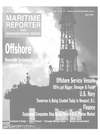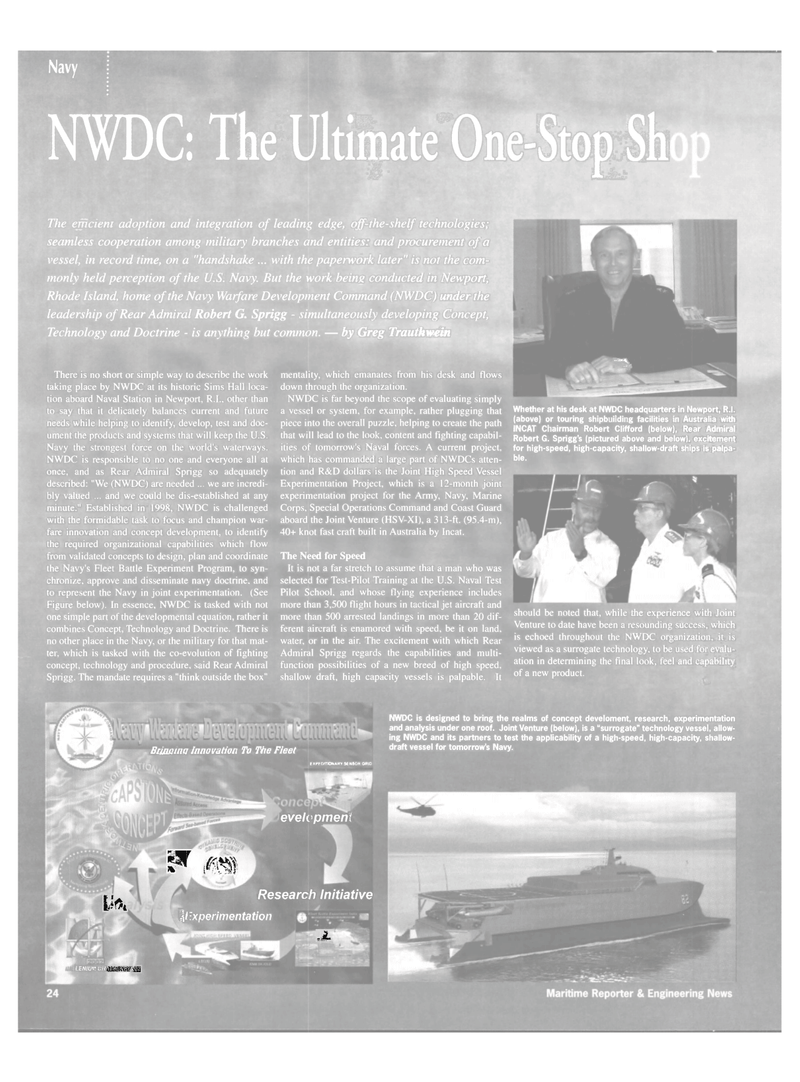
Page 22: of Maritime Reporter Magazine (April 2002)
Read this page in Pdf, Flash or Html5 edition of April 2002 Maritime Reporter Magazine
Navy
NWDC: The Ultimate One-Stog Sh
The adoption and integration of leading edge, off-the-shelf technologies; seamless cooperation among military branches and entitlejft and procurement of a vessel, in record time, on a "handshake ... with the paperwork later" is not the com- monly held perception of the U.S. Navy. But the work beinMconducted in Newport,
Rhode Island, home of the Navy Warfare Development Command (NWDC) under the leadership of Rear Admiral Robert G. Sprigg - simultaneously developing Concept,
Technology and Doctrine - is anything but common. — by Greg Trauthwein
There is no short or simple way to describe the work taking place by NWDC at its historic Sims Hall loca- tion aboard Naval Station in Newport, R.I., other than to say that it delicately balances current and future needs while helping to identify, develop, test and doc- ument the products and systems that will keep the U.S.
Navy the strongest force on the world's waterways.
NWDC is responsible to no one and everyone all at once, and as Rear Admiral Sprigg so adequately described: "We (NWDC) are needed ... we are incredi- bly valued ... and we could be dis-established at any minute." Established in 1998, NWDC is challenged with the formidable task to focus and champion war- fare innovation and concept development, to identify the required organizational capabilities which flow from validated concepts to design, plan and coordinate the Navy's Fleet Battle Experiment Program, to syn- chronize, approve and disseminate navy doctrine, and to represent the Navy in joint experimentation. (See
Figure below). In essence, NWDC is tasked with not one simple part of the developmental equation, rather it combines Concept, Technology and Doctrine. There is no other place in the Navy, or the military for that mat- ter, which is tasked with the co-evolution of fighting concept, technology and procedure, said Rear Admiral
Sprigg. The mandate requires a "think outside the box" mentality, which emanates from his desk and flows down through the organization.
NWDC is far beyond the scope of evaluating simply a vessel or system, for example, rather plugging that piece into the overall puzzle, helping to create the path that will lead to the look, content and fighting capabil- ities of tomorrow's Naval forces. A current project, which has commanded a large part of NWDCs atten- tion and R&D dollars is the Joint High Speed Vessel
Experimentation Project, which is a 12-month joint experimentation project for the Army, Navy, Marine
Corps, Special Operations Command and Coast Guard aboard the Joint Venture (HSV-XI), a 313-ft. (95.4-m), 40+ knot fast craft built in Australia by Incat.
The Need for Speed
It is not a far stretch to assume that a man who was selected for Test-Pilot Training at the U.S. Naval Test
Pilot School, and whose Hying experience includes more than 3,500 flight hours in tactical jet aircraft and more than 500 arrested landings in more than 20 dif- ferent aircraft is enamored with speed, be it on land, water, or in the air. The excitement with which Rear
Admiral Sprigg regards the capabilities and multi- function possibilities of a new breed of high speed, shallow draft, high capacity vessels is palpable. It iA
Whether at his desk at NWDC headquarters in Mlwportp.l. (above) or touring shipbuilding facilities jit Australia with
INCAT Chairman Robert Clifford (below), Rear Admiral
Robert G. Sprigg's (pictured above and below), excitement for high-speed, high-capacity, shallow-draft ships it palpa- ble. should be noted that, while the experience with Joint
Venture to date have been a resounding success, whifj is echoed throughout the NWDC organizationglft is viewed as a surrogate technology, to be used for evalu- ation in determining the final look, feel and ca||bilt|j of a new product.
Biiwma Innovation To The Fleet
NWDC is designed to bring the realms of concept develoment, research, experimentation and analysis under one roof. Joint Venture (below), is a "surrogate" technology vessel, allow- ing NWDC and its partners to test the applicability of a high-speed, high-capacity, shallow- draft vessel for tomorrow's Navy.
E*CFDmC»,*RK 3f NSOR OHIO evelopment
J m
Un Research Initiative \lixperimentation
WL
LLNIU'-'. t;u Mimmm

 21
21

 23
23
